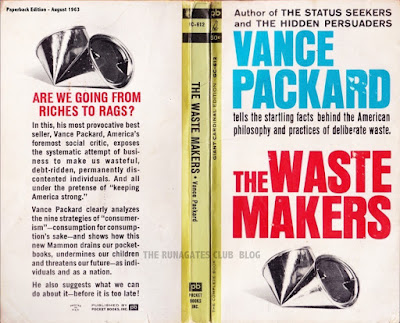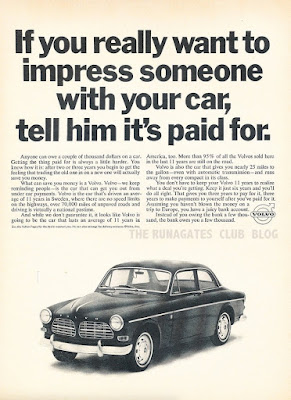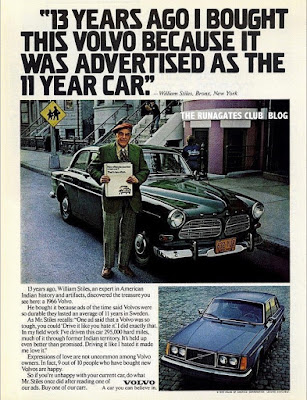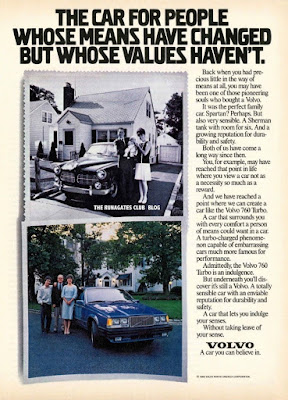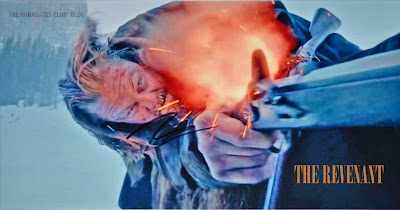This VOLVO advertisement from the 1960s is more
relevant than ever. Our expensive products are made
redundant and valueless at a very alarming rate.
Classic VOLVO ADS - A Gallery of Greats
- Ronald J. Jack
All of us, I think, are annoyed by the constant failure of critical components in our household appliances, bathroom fixtures, consumer electronics and so much more. When they break or wear out, we are faced with disposing of the whole unit and buying a replacement. The alternative is living in a graveyard of failed technology. I recall going through eight drip coffee-makers (in every case a heating element failure) before switching to a simple French Press. I burned through ten desktop laser printers before finding one that could survive 24 months of light usage (a Brother DCP) and I suffered the existence of a dozen pole lamps (all made in China, and priced from $50 to $300) fitted with extremely shoddy dial switches, before learning my lesson. Now I simply pull the plugs from the wall and NEVER reach for the damned switches.
Today I watched a roofing crew rip off and replace my neighbours entire roof, because of a reported leak. The roof was just two years old. They quickly carted away the incriminating evidence - a truck load of new asphalt shingles and 20 sheets of new plywood sheathing. Insane waste. A "rip off" it was.
- Ronald J. Jack
All of us, I think, are annoyed by the constant failure of critical components in our household appliances, bathroom fixtures, consumer electronics and so much more. When they break or wear out, we are faced with disposing of the whole unit and buying a replacement. The alternative is living in a graveyard of failed technology. I recall going through eight drip coffee-makers (in every case a heating element failure) before switching to a simple French Press. I burned through ten desktop laser printers before finding one that could survive 24 months of light usage (a Brother DCP) and I suffered the existence of a dozen pole lamps (all made in China, and priced from $50 to $300) fitted with extremely shoddy dial switches, before learning my lesson. Now I simply pull the plugs from the wall and NEVER reach for the damned switches.
Today I watched a roofing crew rip off and replace my neighbours entire roof, because of a reported leak. The roof was just two years old. They quickly carted away the incriminating evidence - a truck load of new asphalt shingles and 20 sheets of new plywood sheathing. Insane waste. A "rip off" it was.
So what if the products we buy passed a C.S.A. bench test? So many gadgets are designed to fail we take it for granted that nothing we own is permanent. Even if it was "Warranted" most of the time it is is easier to junk the item than search for a receipt. Last week I acquired a used product that is 51 years old, cost 60 cents when new, and shows no sign of wearing out. It is a copy of THE WASTE MAKERS, written by social critic Vance Packard. In his time, at the beginning of the Space Age, there was plenty of debate about the growing dependence of the U.S. economy on planned obsolescence, and the "ethics" of engineers who designed products that would fail on a schedule. At the time the book was published the jury was out, discussing the overwhelming evidence of industry building products that were programmed to fail. We now know the manufacturers won the case. Consumers lost and had to pay all costs. We are still paying.
Packard has chapters on the American automotive industry, and they are of course long out-of-date. Yet one constant remains - the drive to convince us that the cars we own are less desirable than new models in dealer showrooms. It is a pretty good guess that every copy-writer in the advertising industry read Packard's book, because industry counter-measures were not long in coming.
Truth as a Counter-Measure
For a twenty year period, from about 1966 to 1986, the Swedish automobile manufacturer VOLVO, ridiculed "planned obsolescence" in it marketing campaigns. You sometimes encounter their ads if you riffle through the pages of old magazines, and I have collected eight of them here. I hope you enjoy them. VOLVO still employs very effective advertising, but the theme is different.
The VOLVO ad that really started it all:
"This is the eleven year car." [1966]
A companion VOLVO ad in 1966: "If you really want to
impress someone with your car, tell him it's paid for."
The point was made, but it got more interesting. "THE PAPER CAR" With reference to BOTH "planned obsolescence" and the reality of a new, "throw-away society" the wasteful consumer became an accomplice of industry.
This VOLVO ad was the most forceful and blatant on the subject of
planned obsolescence and wasteful consumerism. [THE PAPER CAR! 1967]
Pop culture of the 1960s and 1970s was filled with
references to "The System"and social conformity.
"BEAT THE SYSTEM. BUY A VOLVO." [1971]
In 1979 the campaign matured and VOLVO could literally harvest satisfied customers. Thirteen years had elapsed and many of those 1966 sedans were still on the road.
VOLVO ad 1979 - "13 Years Ago I Bought This Volvo
Because It Was Advertised As The 11 Year Car."
Note that the customer the advertisement featured was an historian. An expert on aboriginal art and culture. "13 years ago, William Stiles, an expert in American Indian history and artifacts, discover the treasure you see here: a 1966 Volvo." How cool was that? Yes, there really was a William Stiles, and there is a Canadian connection. Stiles is featured on the SMITHSONIAN INSTITUTION BLOG (Here). After scoring points by showcasing an expert on well-made artifacts, the folks who ran the VOLVO ad campaign came up with another expert - a psychiatrist.
a In 1980, ad copy that is both clever and amusing:
"Anyone Who's Thinking of Spending $24,000 For A
Luxury Car Should Talk To A Psychiatrist."
In the Ad copy the psychiatrist is quoted: "In my opinion the individual buying this car would have a strong, unsuppressed need to get his or her money's worth. He or she would probably also have a strong enough self-image not to need a blatant status symbol." Ouch! That still hurts, 36 years later.
And then it was 1986. VOLVO customers had worked hard and they had prospered. Another generation of buyers was prowling the car lots, and certainly were influenced by clever advertising. We end our gallery with this great display ad that certainly must have struck a chord with many satisfied drivers: "The Car For People Whose Means Have Changed But Whose Values Haven't." You are either that sort of person, or you are not.
I have never owned or even driven a VOLVO, but there are other quality vehicles on the roads.

